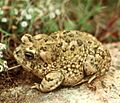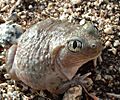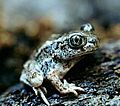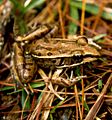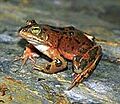List of amphibians of California facts for kids
Amphibians are amazing creatures that can live both in water and on land! They are a special group of animals that includes frogs, toads, salamanders, and newts. Unlike reptiles, amphibians have smooth, moist skin and usually lay their eggs in water. When they are young, many amphibians live in water and breathe with gills, like fish. As they grow up, they change, developing lungs to breathe air and legs to move on land. This transformation is called metamorphosis.
Contents
Amphibians: Frogs, Toads, and Salamanders
Amphibians are found all over the world, from forests to deserts, but they always need access to water for at least part of their lives. They are an important part of many ecosystems, eating insects and other small creatures, and in turn, becoming food for larger animals.
Frogs and Toads (Order Anura)
Frogs and toads belong to a group called Anura, which means "without a tail." This is a key difference from salamanders! Frogs generally have smooth, moist skin and long legs for jumping, while toads often have drier, warty skin and shorter legs for walking or hopping.
Tailed Frogs (Family Ascaphidae)
Tailed frogs are quite unique! They are found in cool, fast-flowing streams. The "tail" is actually a special part used for reproduction.
- The Coast tailed frog (Ascaphus truei) is one example. It's a small frog that lives in cold mountain streams.
True Toads (Family Bufonidae)
True toads are known for their bumpy skin and often have glands behind their eyes that can release a milky substance to protect them from predators.
- The Western toad (Anaxyrus boreas halophilus) is a common toad found in many parts of western North America.
- The Yosemite toad (Anaxyrus canorus) lives in the Sierra Nevada mountains and is known for its beautiful markings.
- The Red-spotted toad (Bufo punctatus) has small red spots and can be found in rocky, dry areas.
- The Woodhouse's toad (Bufo woodhousii) is a larger toad often found near water sources.
Tree Frogs and Chorus Frogs (Family Hylidae)
Many frogs in this family are excellent climbers, with sticky pads on their toes that help them grip surfaces. They are often called "tree frogs" or "chorus frogs" because of their loud calls.
- The California chorus frog (Pseudacris cadaverina) is a small frog with a distinctive call.
- The Northern Pacific chorus frog (Pseudacris regilla) is one of the most common frogs in western North America, known for its "ribbit" sound.
Spadefoot Toads (Family Scaphiopodidae)
Spadefoot toads are special because they have a hard, spade-like growth on their hind feet. They use this "spade" to dig backwards into the soil, where they can hide from the sun and wait for rain.
- Couch's spadefoot (Scaphiopus couchii) is found in desert areas and quickly emerges after heavy rains to breed.
- The Western spadefoot (Spea hammondii) is another species that buries itself to escape dry conditions.
True Frogs (Family Ranidae)
This family includes many of the frogs you might think of as "typical" frogs. They often have smooth skin, long legs, and are excellent jumpers. Many live near ponds, lakes, and streams.
- The Northern red-legged frog (Rana aurora) is known for the reddish color on its underside.
- The American bullfrog (Rana catesbeiana) is the largest frog in North America and has a very deep, loud call.
- The California red-legged frog (Rana draytonii) is a protected species, famous for its role in Mark Twain's story, "The Celebrated Jumping Frog of Calaveras County."
- The Northern leopard frog (Lithobates pipiens) has distinct dark spots that look like a leopard's.
Clawed Frogs (Family Pipidae)
Clawed frogs are mostly aquatic, meaning they spend almost all their lives in water. They have flattened bodies and webbed feet with claws, which they use to tear apart food.
- The African clawed frog (Xenopus laevis) is a well-known species from this family.
Salamanders and Newts (Order Caudata)
Salamanders and newts belong to the group Caudata, which means "with a tail." Unlike frogs and toads, they keep their tails throughout their lives. They usually have long bodies and four short legs.
Mole Salamanders (Family Ambystomatidae)
These salamanders often live underground in burrows, coming out mainly to breed or during wet weather. They are known for their sturdy bodies.
- The California tiger salamander (Ambystoma californiense) is a large, striking salamander with yellow spots or bars.
- The Northwestern salamander (Ambystoma gracile) is found in damp forests.
- The Long-toed salamander (Ambystoma macrodactylum) has a long fourth toe on its hind feet.
Giant Salamanders (Family Dicamptodontidae)
As their name suggests, these are some of the largest salamanders in North America. They live in cool, moist forests and streams.
- The California giant salamander (Dicamptodon ensatus) can grow quite large.
- The Pacific giant salamander (Dicamptodon tenebrosus) is another impressive species found in the Pacific Northwest.
Lungless Salamanders (Family Plethodontidae)
This is the largest family of salamanders. What makes them special is that they don't have lungs! They breathe through their skin and the lining of their mouths. This means they need to keep their skin moist.
- The Arboreal salamander (Aneides lugubris) is a climbing salamander often found in trees.
- Slender salamanders (genus Batrachoseps) are very thin and worm-like, often found under logs or rocks. Examples include the California slender salamander (Batrachoseps attenuatus) and the Garden slender salamander (Batrachoseps major).
- The Ensatina (Ensatina eschscholtzii) is a common salamander known for its bright colors and a constriction at the base of its tail.
- Hydromantes salamanders, like the Limestone salamander (Hydromantes brunus), are often found in caves or rocky crevices.
Torrent Salamanders (Family Rhyacotritonidae)
These small salamanders are adapted to living in cold, clear, fast-flowing streams and springs.
- The Southern torrent salamander (Rhyacotriton variegatus) is an example of this unique group.
Newts (Family Salamandridae)
Newts are a type of salamander that often have rougher skin than other salamanders. Many newts have a special "eft" stage where they live on land before returning to water as adults to breed.
- The Rough-skinned newt (Taricha granulosa) is famous for its toxic skin, which protects it from predators.
- The California newt (Taricha torosa) is a common newt found in California.
- The Red-bellied newt (Taricha rivularis) has a bright red or orange belly.
Images for kids





